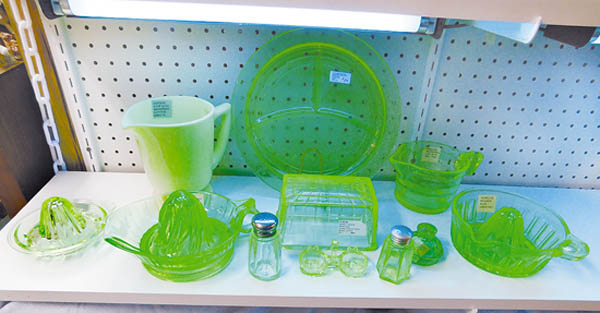Collectible Uranium Glass At The Grist Mill
By Diane Fanucci - May 14, 2021
Did you ever wonder how they got that magical green-yellow color in Vaseline glass? The secret ingredient is uranium oxide, hence being coined uranium glass. The ancient Romans were the first ones to utilize uranium in glassmaking. Uranium glass became popular during the mid-19th century, particularly from the 1880s to the 1920s. The current sales display at the Grist Mill Antiques Center offers an array of the collectible glass . An ultraviolet light, also known as a black light, shows off the amount of uranium in each piece, which must be viewed in person to capture the true beauty of each piece. Ultraviolet light activates electrons that cause the glow. Even though a Geiger counter will register slightly above average background radiation when uranium glass is scanned, the amount is negligible, and the glass is safe for use. It was made for eating and drinking but has become collectible for display purposes. Even some vintage Jadeite glass was made using uranium, so those pieces will also glow under a black light. This process was used only in the 1940s, so visitors will want to put any pieces under a black light (serious collectors carry a black light flashlight with them) to see if they are from that era. Uranium was also used to create the orange, yellow and green glazes on Cloisonne jewelry and even some Fiestaware glazes made before 1973. Vaseline glass production stopped in 1943 because regulations on the use of uranium were implemented. Fifteen years later, in 1958, the regulations were relaxed, and Vaseline glass production resumed. The Grist Mills sales display of Vaseline glass is under black light. The multi-dealer store is open seven days a week from 10 a.m. to 5 p.m. It is located in Pemberton Borough, at 127 Hanover St., Pemberton, N.J., right next to the bridge over the scenic Rancocas Creek. For directions or additional information, call 609-726-1588.



SHARE
PRINT